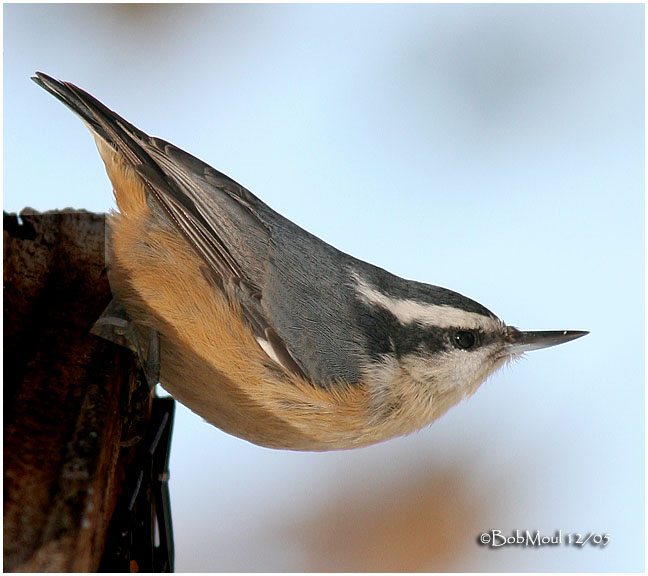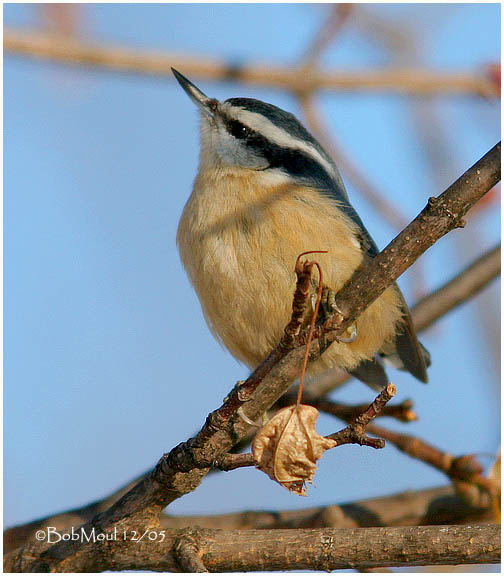
Red-breasted Nuthach
Sitta Canadensis
Passeriforme Order – Sittidae Family
BIOMETRICS:
Length: 11 cm; Wingspan: 18-20 cm; Weight: 8-13 g
LONGIVITY: up to 7 years
DESCRIPTION:
Red-breasted nuthatch is smaller than Eurasian nuthatch, with much smaller, shorter and finer bill, and very different head pattern with all dark crown, and bold white supercilium above dark eye stripe. Cheeks are white. It has grey back, underparts are reddish, legs and feet are dark grey.
Female has blue-grey crown, and is paler underneath and has a narrower eye stripe.
Juvenile is duller than adults.

VOICE: SOUNDS BY XENO-CANTO
Red-breasted nuthatch’s usual call is a slow, high, nasal, far-carrying “nyahk-nyahk-nyahk” recalling toy tin horn. It gives more rapid series when agitated. This call also serves as a territory song. Contact call is a soft “pit”.
HABITAT:
Red-breasted nuthatch is found in coniferous (spruce or pine) or mixed forests. It lives also in suburban habitat with sufficient conifers.
RANGE:
Red-breasted nuthatch breeds from NW Canada to California, through the Rocky Mountains and across the border and Great Lakes region. It breeds also southwards from Newfoundland to the Appalachians.
It winters in breeding range and irregularly south to Gulf Coast and northern Florida.
Movements depend of the food resources.
BEHAVIOUR:
Red-breasted nuthatch is able to walk down trees (head first) in its search for food. This bird spends most of its life in large trees. They work they way down a tree trunk, searching for grubs and insects in the bark crevices. They move over bark of trees very rapidly or wind about small twigs and needles of conifers at the end of branches, dart out into air for flying insects.

Red-breasted nuthatch pries open the pine cone scales with the bill to extract seeds. They are provident birds by gathering seeds when abundant, storing them under lichens, bark and other suitable hiding places, retrieving them when food is scarce.
Red-breasted nuthatches travel in small flocks at the end of summer to migrate. They are gregarious, chattering constantly among themselves. They are monogamous. Pairs remain together on their feeding territories if the corn crop has been good, or alternately, if they are close to a feeding station. Courtship displays are usually carried out among the branches and tops of coniferous trees.
FLIGHT:
Red-breasted nuthatch has an agile and rapid flight.
REPRODUCTION:
Both adults usually excavate a nesting place in a dead stub or limb of pine and other trees. Nest can be located at 5 to 100 feet high, usually about 15 feet above ground. It can also use an old nest of woodpecker.
Red-breasted nuthatch applies sticky conifer resin globules to the entrance of its nest hole. It may carry the resin in its bill or on pieces of bark that it uses as an applicator. Male puts it around the outside while female puts it around the inside. Resin may keep out predators. Red-breasted nuthatch avoids it by diving directly through the hole. Nest is made with grasses, rootlets, mosses, shreds of bark and plant fibres. It’s lined with finer materials.

Female lays 5 to 6 white or creamy non glossy eggs, spotted brown. Incubation lasts about 12 days, by female alone. The first young bird leaves the nest about 18 to 21 days after hatching.
Both parents feed them.
DIET:
Red-breasted nuthatch is very fond of seeds of pines and other conifer trees.
In spring and summer, it feeds on beetles, wasps, caterpillars, insect eggs and crane flies. It comes to feeding stations for suet, chopped kernels of walnuts, pecans, peanuts and sunflowers seeds.
Young are fed with 100% animal food.
PROTECTION / THREATS / STATUS:
Populations of Red-breasted nuthatches are increasing throughout most of the range.
Fr: Sitelle à poitrine rousse
All : Kanadakleiber
Esp: Trepador Canadiense
Ital: Picchio muratore pettofulvo
Nd: Zwartkopboomklever
Russe: Поползень черноголовый
Sd: Rödbröstad nötväcka
Photos de Bob Moul :
Son site : Nature Photography
Texte de Nicole Bouglouan
Sources :
HANDBOOK OF THE BIRDS OF THE WORLD Vol 13 by Josep del Hoyo-Andrew Elliot-Jordi Sargatal - Lynx Edicions – ISBN: 9788496553453
FIELD GUIDE TO THE BIRDS OF NORTH AMERICA - National Geographic Society - ISBN: 0792274512
THE HANDBOOK OF BIRD IDENTIFICATION FOR EUROPE AND THE WESTERN PALEARCTIC by Mark Beaman, Steve Madge - C.Helm - ISBN: 0713639601
All About Birds (Cornell Lab of Ornithology)
Bird Web (Seattle Audubon Society)
What Bird-The ultimate Bird Guide (Mitchell Waite)
Animal Diversity Web (University of Michigan Museum of Zoology)